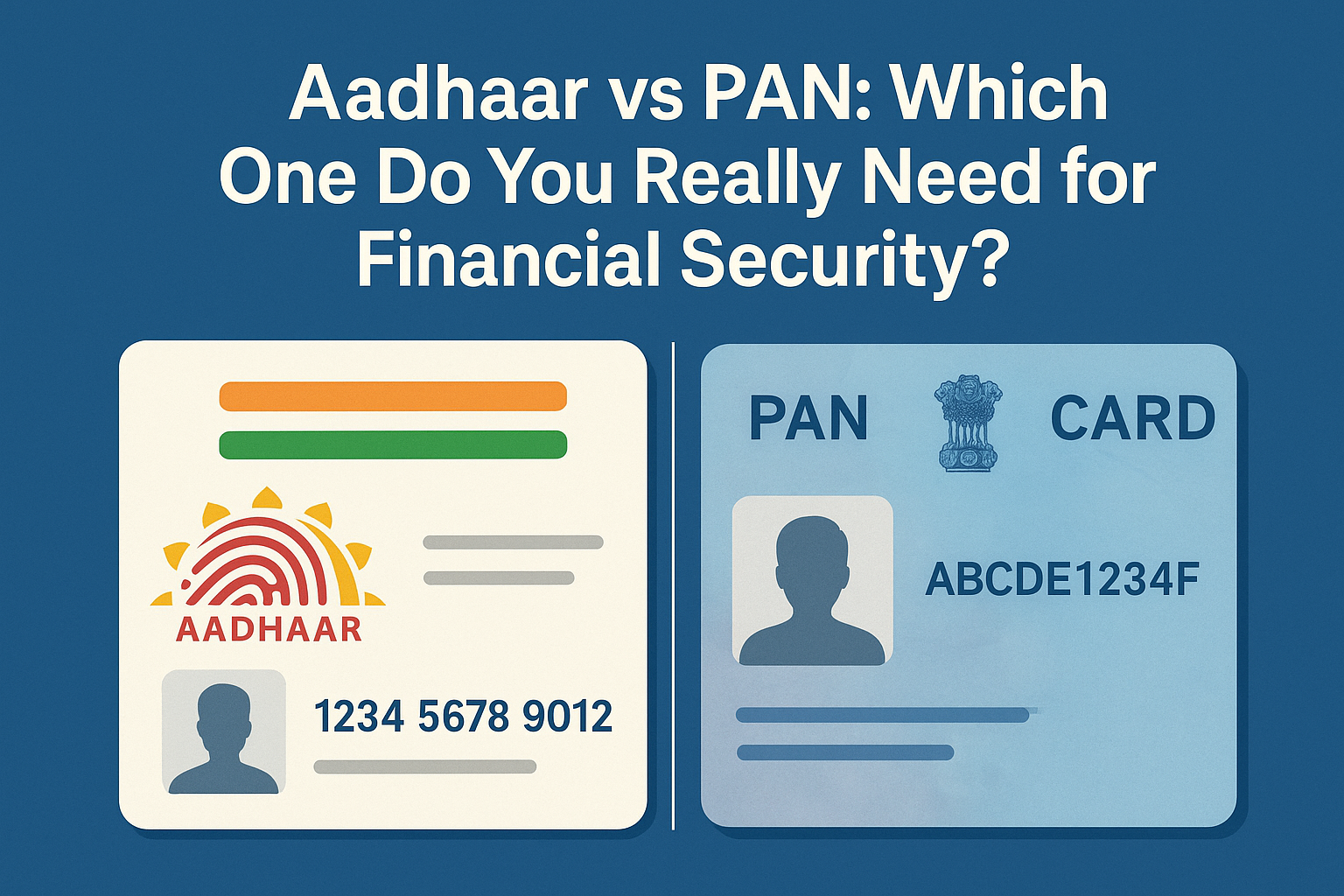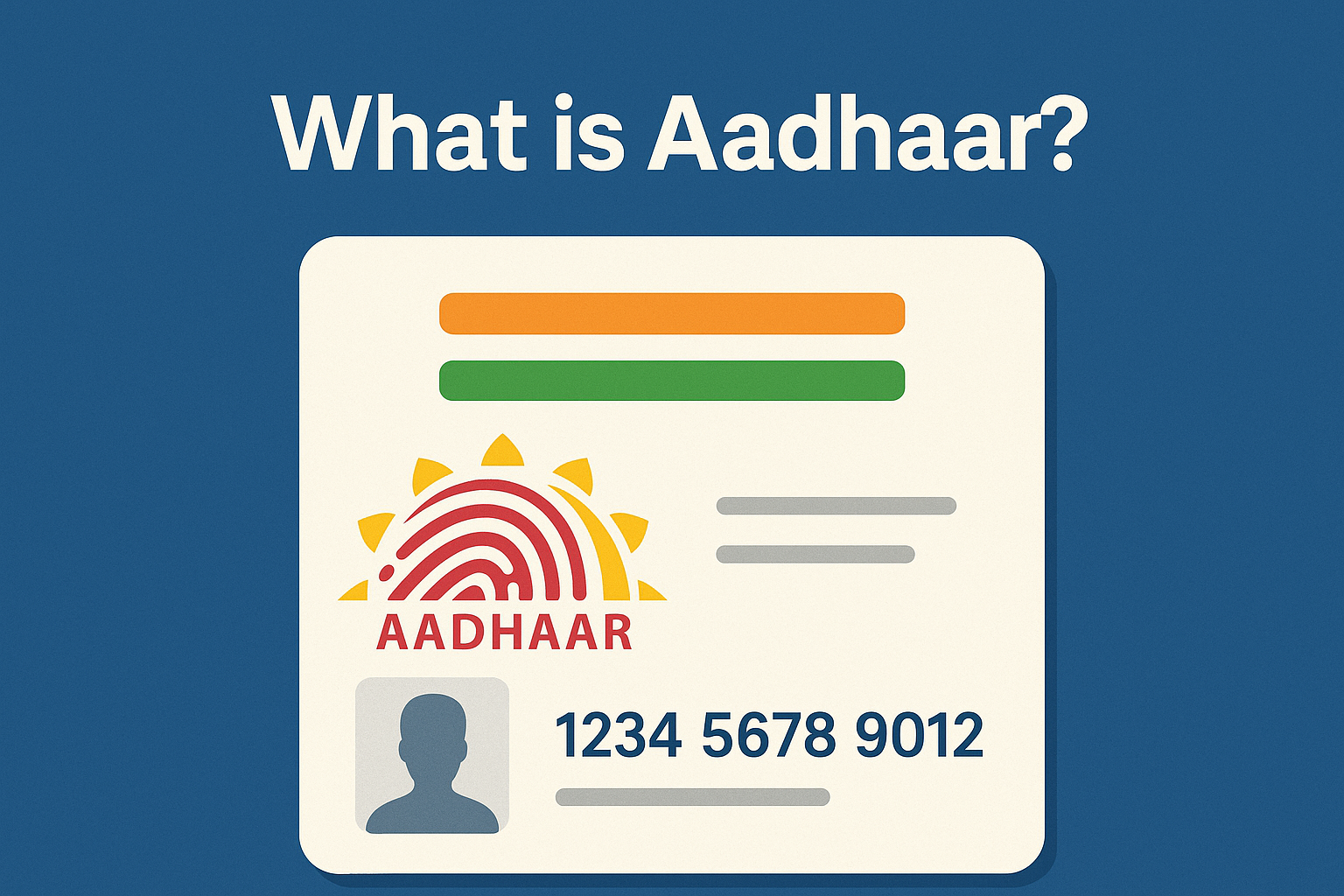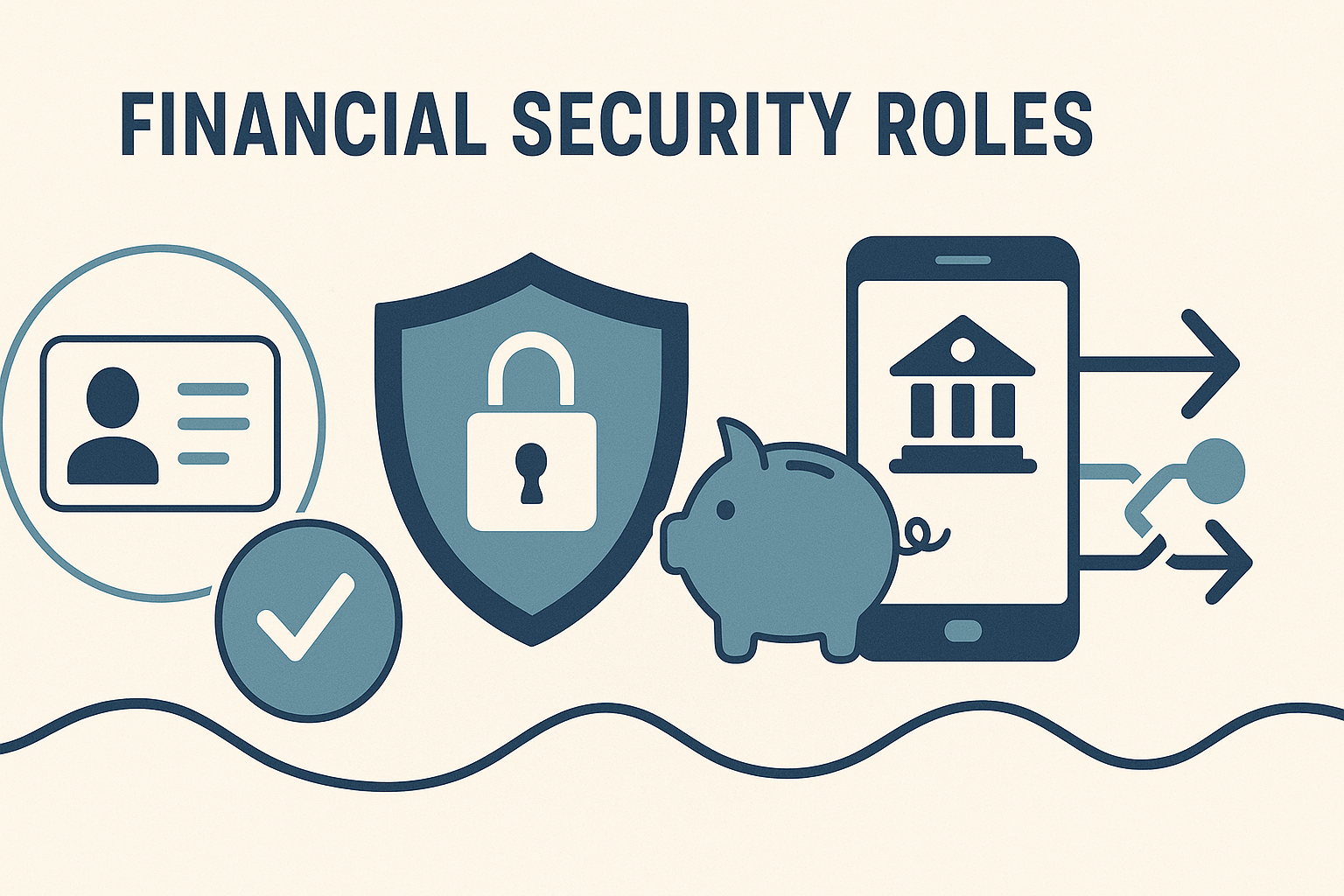
Aadhaar vs PAN: Which One Do You Really Need for Financial Security?
Meta Description: Understand the core differences between Aadhaar and PAN, their roles in financial security, legal implications of non-compliance, and a step-by-step guide to linking your IDs. Learn which ID to prioritise and debunk common myths in this comprehensive 3,000-word guide.
Introduction
In today’s digitised India, two government-issued identifiers—Aadhaar and Permanent Account Number (PAN)—sit at the heart of financial and identity ecosystems. While both serve as proof of identity, their purposes, issuance authorities, and applications differ significantly. This guide takes you through
Core differences between Aadhaar and PAN
Their roles in financial security
Legal implications of not linking your IDs
Prioritization based on your requirements
A step-by-step linkage process
Common myths and realities
A targeted FAQ section to address People Also Ask queries
By the end of this article, you’ll know exactly when to use Aadhaar vs. PAN, how to stay compliant, and how to leverage both IDs to maximise convenience and security.

1. Core Differences Between Aadhaar and PAN
| Aspect | Aadhaar | PAN |
|---|---|---|
| Structure | 12-digit numeric biometric ID | 10-character alphanumeric code |
| Issuing Authority | Unique Identification Authority of India (UIDAI) | Income Tax Department (ITD) |
| Purpose | Universal identity verification across schemes | Tracking and monitoring financial transactions for tax compliance |
| Residency | Issued exclusively to Indian residents | Available to both residents and non-residents for financial activities |
| Data Stored | Demographic + biometric (fingerprints, iris, photo) | No biometric data; linked to financial and tax records |
1.1 Structure and Issuance
PAN
Format: five letters, followed by four numerals, ending with a letter (e.g., AAAAA9999A).
Issued by: Central Board of Direct Taxes under the Income Tax Department.
Applicability: Mandatory for individuals and entities engaging in taxable transactions (e.g., salary income, business operations, capital gains).
Aadhaar
Format: A 12-digit random number.
UIDAI, an autonomous agency under the Ministry of Electronics & IT, issues the Aadhaar format.
Applicability: Used across government and private services for KYC, welfare schemes, scholarships, and much more.
Key Takeaway: While PAN is strictly tax-centric, Aadhaar functions as a universal identifier, making it indispensable for a broad array of services beyond taxation.
2. Financial Security Roles

2.1 PAN’s Role in Financial Security
Tax Compliance & Monitoring
Tracks taxable transactions: property purchases, mutual fund investments, high-value insurance policies, and more.
It is essential to file income tax returns (ITR), which unify all financial transactions into a unified identity.
Preventing Tax Evasion
The Income Tax Department flags unreported high-value transactions to curb black money.
Non-filers with transactions exceeding threshold limits incur penalties.
Enabling Financial Services
You must open demat accounts, trade stocks and derivatives, and obtain corporate credit cards.
This information serves as the foundation for your tax history, credit score, and loan approvals.
2.2 Aadhaar’s Role in Financial Security
Simplified KYC
Banks and financial institutions leverage Aadhaar e-KYC to onboard customers swiftly, reducing paperwork.
A single Aadhaar can replace multiple documents for identity and address proof.
Biometric Authentication
Fingerprint/iris-based verification mitigates identity fraud, ensuring genuine customer onboarding.
This technology enhances digital transactions through the Aadhaar-enabled Payment System (AePS).
Subsidies & Welfare
Direct Benefit Transfers (DBT) of LPG subsidies, MNREGA wages, and scholarships hinge on Aadhaar-linked bank accounts.
This process removes intermediaries and guarantees that the intended beneficiaries receive the benefits.
2.3 Synergy: The Power of Linking
Mandatory Linking: Under the Finance Act, 2017, linking Aadhaar with PAN has been compulsory to file ITRs or face PAN deactivation.
Fraud Prevention: Prevents duplicate or fictitious PAN allocations, consolidating financial identities.
Seamless Compliance: Once linked, transactions and tax filings become more streamlined, reducing manual cross-verification.
3. Legal Implications of Non-Compliance

3.1 PAN-Aadhaar Linking Mandate
Legislative Basis: The Finance Act, 2017, introduced Section 139AA, mandating Aadhaar-PAN linkage.
Deactivation Risk: Failure to link by stipulated deadlines results in PAN invalidation, blocking ITR filing, bank account operations, and high-value transactions.
3.2 Recent Updates & Deadlines
July 2024 Enforcement: As of July 1, 2024, any unlinked PAN is deemed inoperative for all financial and tax-related transactions.
Late Fees: Post-deadline, late linkage incurs a penalty of ₹1,000 under Section 234H.
Deadline Extensions: While the government has occasionally extended deadlines, the latest notifications confirm no further extensions beyond mid-2024.
Consequences of Non-Compliance:
Invalid PAN: Blocks ITR submission, complicates tax refunds and assessments.
Transaction Hurdles: High-value banking and investment transactions get flagged or rejected.
Penalty Exposure: Late fees and potential scrutiny from tax authorities.
4. Which One Should You Prioritise?
4.1 For Indian Taxpayers
First Priority: PAN
Without a PAN, you cannot file taxes, open a demat account, or engage in most financial activities.
Maintaining a clean tax record and avoiding TDS (Tax Deducted at Source) issues is crucial.
Second Priority: Aadhaar
Aadhaar is essential for KYC, welfare schemes, and e-signatures on tax forms.
It simplifies the process of conducting business and gaining access to government benefits.
4.2 For Subsidy & Welfare Beneficiaries
Aadhaar Comes First
To receive government subsidies (e.g., PG Diploma scholarships, Ujjwala Yojana), Aadhaar-linked bank accounts are mandatory.
This allows for real-time biometric authentication during the disbursal of benefits.
PAN as Backup
PAN ensures that subsidy amounts are reported correctly in your income tax filings, preventing discrepancies.
4.3 For Non-Resident Indians (NRIs)
PAN Only
NRIs cannot enrol for Aadhaar but must obtain a PAN for investing in Indian securities, filing ITRs, or purchasing property.
PAN enables repatriation of funds and compliance with FEMA (Foreign Exchange Management Act).
5. Step-by-Step Guide to Linking PAN and Aadhaar
Linking PAN with Aadhaar is a quick process that can be completed online in under five minutes.
Access the Income Tax e-Filing Portal
Navigate to incometaxindiaefiling.gov.in.
Click on the “Link Aadhaar” option under the Quick Links section.
Enter Your Details
PAN: Input your 10-digit PAN.
Aadhaar: Enter your 12-digit Aadhaar number as printed on your Aadhaar card or masked e-Aadhaar.
Name Matching: Ensure your name on PAN matches exactly with Aadhaar. Minor discrepancies (e.g., initials vs. full name) may cause rejection.
Validate with OTP
Tick the consent box to confirm your mobile number is linked with your Aadhaar for OTP-based verification.
Click “Continue” and enter the OTP received on your Aadhaar-registered mobile number.
Submit & Confirmation
Upon successful OTP validation, you will see a confirmation message along with an acknowledgement number.
No payment is required if you link by the deadline.
Late Linkage Fee (If Applicable)
If you miss the deadline, you must first file ITR-1 or ITR-4 payable under Section 234H with an additional ₹1,000.
After ITR submission, repeat the Aadhaar-PAN linking steps.
Pro Tip: Keep screenshots or acknowledgment numbers as proof of linkage in case of future disputes.
6. Common Myths Debunked
| Myth | Reality |
|---|---|
| “Aadhaar can fully replace PAN.” | Aadhaar streamlines KYC but cannot fulfil tax reporting obligations; PAN remains mandatory for ITR. |
| “Linking isn’t urgent; it has no penalties.” | Delays lead to PAN invalidation, blocking financial transactions and inviting penalties. |
| “NRIs must link Aadhaar to maintain PAN.” | Aadhaar is for residents only; NRIs simply retain their PAN for compliance. |
| “Biometric linking compromises privacy.” | UIDAI employs robust encryption; biometric data is stored securely and only used for authentication. |
FAQ Section
Q1. Can I use Aadhaar instead of PAN for banking?
A: No. While Aadhaar simplifies KYC for account opening, PAN is mandatory for any taxable financial transaction (e.g., fixed deposits above ₹50,000, mutual fund investments, and salary accounts). Banks will still require your PAN for tax reporting under Section 194A and other provisions.
Q2. What happens if I don’t link PAN-Aadhaar?
A: Your PAN becomes inoperative, preventing you from:
Filing Income Tax Returns.
Receiving tax refunds or carrying forward losses becomes unfeasible.
They are also involved in high-value transactions such as property and investments.
One may need to open new bank accounts or apply for loans.
Q3. Do NRIs need to link PAN-Aadhaar?
A: No. Only Indian residents receive Aadhaar. NRIs must maintain their PAN to:
File ITR for Indian-sourced income.
Comply with FEMA for investments and repatriations.
Avoid TDS at higher rates based on Indian income.
Q4. What documents are required to apply for PAN?
A: The basic documents include
Proof of Identity (POI): Passport, Aadhaar, Voter ID, etc.
Proof of Address (POA): Utility bills, passports, and bank statements.
Proof of Date of Birth: birth certificate, Aadhaar, passport.
You can file PAN applications online through NSDL/UTIITSL portals or offline through TIN-FCs.
Conclusion
Aadhaar and PAN serve complementary yet distinct purposes in India’s financial and identity frameworks. PAN is the bedrock of your tax identity—non-negotiable for filing ITRs and engaging in financial transactions. Aadhaar, on the other hand, offers universal identity verification, streamlining KYC, subsidies, and digital services. Linking both ensures
Regulatory Compliance: Avoid PAN deactivation and legal penalties.
Operational Convenience: Faster bank onboarding, e-signatures, and effortless subsidy disbursal.
Enhanced Security: Biometric authentication reduces fraud in both financial and welfare contexts.




